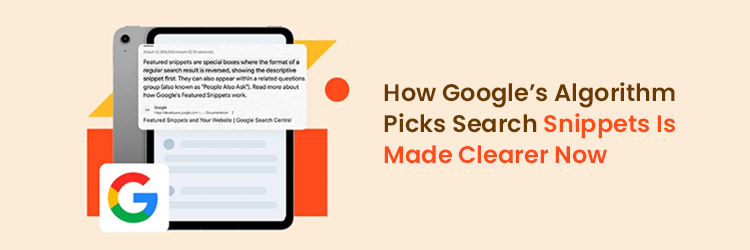How Google’s Algorithm Picks Search Snippets is Made Clearer Now

The search snippets under blue links on Google’s results pages are crucial in providing concise previews of pages to searchers. Optimizing snippets has long been an SEO focus. However, confusion has surrounded exactly how Google’s systems select snippet content.
But recently, Google updated its documentation to bring much-needed clarity to this algorithmic process. This post will cover Google’s updated guidance, additional insights from Google representatives, and key implications for on-page optimization.
The Role of Snippets in Google Results
Snippets contain the following elements:
- Title of the web page
- Breadcrumb URL
- 1-2 sentences describing the page content
These snippets aim to concisely inform searchers about the relevance of a result to their query. Compelling snippets can improve click-through rates.
Snippets provide a vital preview before committing to a click. High-quality snippets enhance the overall search experience.
The Old Guidance on Snippet Generation
In the past, Google’s documentation suggested that snippets were derived from multiple sources:
- Page Content
- Meta descriptions
- Structured data
The phrasing implied meta descriptions were a primary snippet source. Many SEOs focused heavily on keyword-optimized meta descriptions.
However, testing showed meta descriptions were not guaranteed to be used. This confused how much influence metals had.
Structured data was also referenced as a potential snippet source. But in practice, markup did not factor into snippet selection.
So, the documentation did not align with algorithmic reality.
Google’s Updated Snippet Guidance
To clarify how snippets are generated, Google released the following updated documentation:
“Google primarily uses the content on the page to determine the appropriate snippet automatically. We may also use descriptive information in the meta description element when it describes the page better than other content parts.”
The key takeaways are:
- The page content is the primary snippet source
- Meta descriptions play a secondary role
Google also removed all references to structured data having any influence on snippets.
Also Read:- Why Are Facebook Ads Such An Effective Social Media Marketing Tool In 2023?
Direct Insights from Google Representatives
Additional insights from Googlers via public comments and conferences further reinforce the updated guidance:
John Mueller, Search Advocate at Google, confirmed directly that the page content is the “main source” for snippets.
During a Reddit AMA,
Dan Petrovic shared guidance from Google that “meta descriptions should be written like a pitch.” The key is accurately describing and “selling” the page to searchers.
As Petrovic noted, keywords and optimization are not the focus for metal. Their role is to enhance the user experience, not rankings.
Why This Change Matters for SEO
With this clarification, the impact of on-page optimization is profound:
- Focus on content quality – Creating comprehensive, informative content optimized for users is more important than ever. This drives great snippets aligned with queries.
- Meta descriptions – These should concisely and engagingly summarize page content. Keyword stuffing could trigger alternate snippets from page text.
- No shortcut for content – Structured data, metas, etc., cannot substitute for comprehensive content. Google is doubling down on sniffing out “thin” pages.
So, producing robust, useful content that comprehensively covers topics is the best snippet optimization strategy.
Guidance for Optimizing Snippets
Here are some best practices based on the updated guidance:
- Ensure content is weighted toward the beginning paragraphs. Google often selects snippets from higher up on pages.
- Include concise summarizing sentences and transitions between topics. These provide snippet candidates.
- Use meta descriptions under 160 characters summarizing the essence of the content for searchers.
- If your meta description is ignored, the page content may need improvement. Treat it as a signal to enhance quality.
- Check Search Console data on query impressions and clicks to identify pages/queries where snippets can be better optimized.
- For news/media sites, ensure article summaries are included early on. These frequently get selected by Google.
With Google’s algorithms leveraging page content more heavily, creating high-quality snippets begins with providing an excellent user experience through comprehensive, engaging content.
Also Read:- Local SEO Tips To Scale Your Small Business
Conclusion
Google has clarified that page content is the primary driver of search snippets. While meta descriptions play a supplemental role, on-page content is king.
For SEO professionals, this guidance represents an opportunity. By realigning efforts around content quality and user experience, we can create pages that organically produce outstanding snippets aligned with search queries. Reliable, comprehensive content paves the way for snippet success.
The SEO team at Matebiz Pvt Ltd authored this post. As an SEO agency, we help brands improve online visibility through technical audits, site optimization, and data-driven strategies. Reach out if your brand needs support enhancing search performance and presence.








